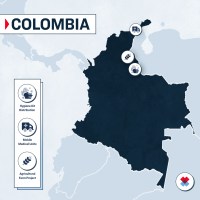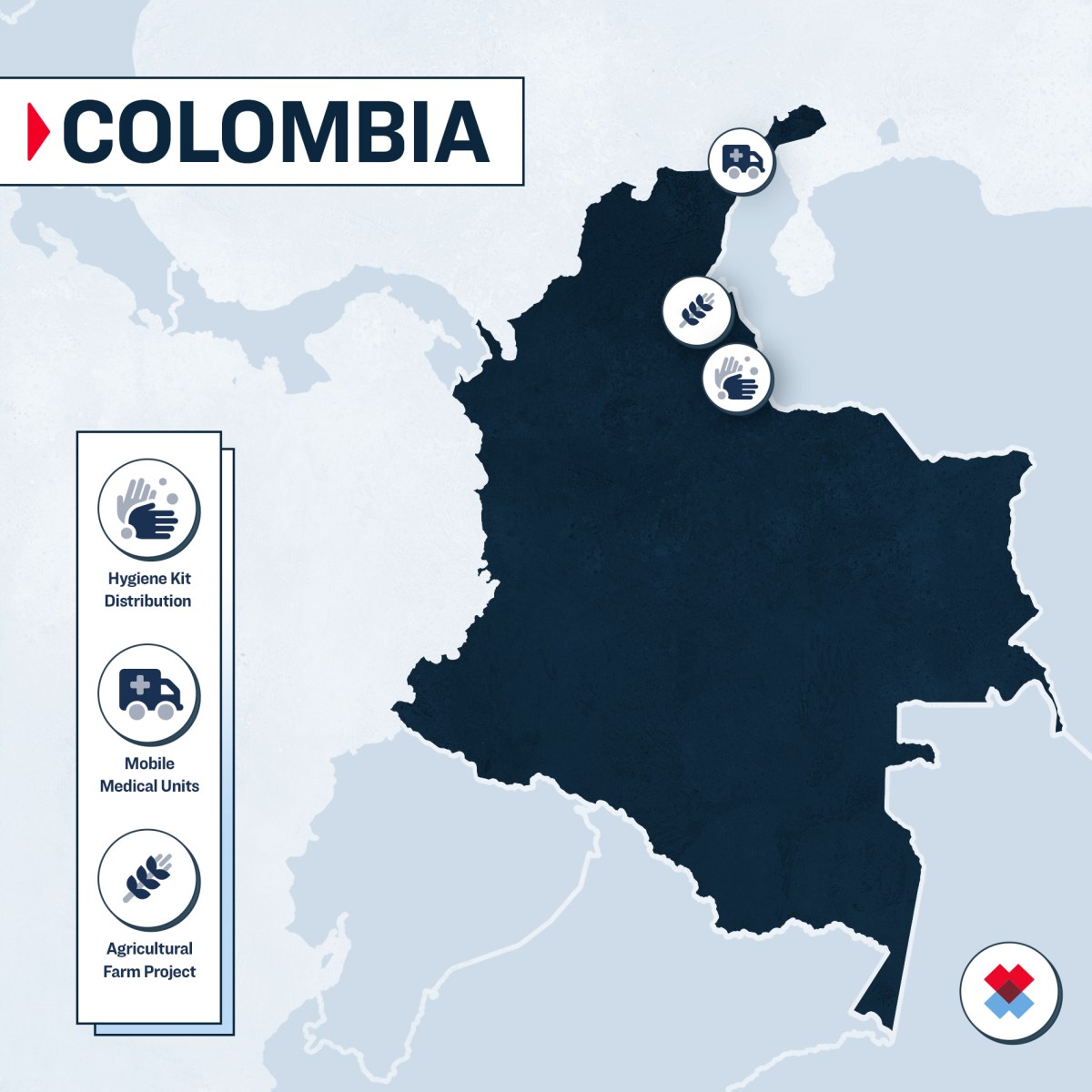Country Overview
Colombia struggles to move past its violent past and into peace. A historic yet fragile peace deal signed in 2016 is faltering as the present administration fails to honor its agreements. Armed groups have grown in power since 2016, increasing violence in rural areas, where environmental activists are assassinated with impunity. Countrywide protests over economic inequality and rising inflation exacerbated by the COVID-19 pandemic reflect the public’s deep distrust of and frustration with government leaders. Over 39% of the Colombian people were living in poverty in 2021. Venezuelan migrants pour into Colombia in the wake of their own country’s economic and social service collapse, resulting in over 1.8 million Venezuelans living in Colombia by the end of 2021. Colombians hope for broad socio-economic changes that will bring more economic and social equality, less corruption, and lasting peace.
We started building our holistic programming based on our core values in mid-2021. After listening to our migrant friends through a pilot project providing health care and food relief in 2020, we designed a programmatic response to address the needs of Venezuelan migrants in Colombia’s border towns, where our migrant friends struggle to find water, food, and medicine. Our community of peacemakers’ generosity allowed us to respond in the following ways:
- 203 moms, dads, kids, and the elderly received hygiene kits as they made their way along the caminante route, walking from Venezuela to and through Colombia, some headed south to Ecuador, Peru, and Chile.
- 24 community members were supported by agricultural projects.
- The program infrastructure necessary to bring mobile medical units to indigenous communities in northeastern Colombia was set up. This medical support will draw on both western and ancestral knowledge.
- 100 families who didn’t have food to make lunch or dinner ate nourishing soup filled with gathered vegetables, plantains, potatoes, and meat after we delivered 30 bags of dehydrated soup, each containing 80 portions, to a settlement near the border. We stayed, helping to cook the soup for a community event, listening and leaning in.
- 23 vulnerable families received 160 meals upon our second visit to the settlement. We also delivered additional bags of dehydrated soup for an upcoming community event to promote social cohesion within their community.
The 50-Year Civil War
260,000 men, women, and children, predominantly in rural communities, were killed by their neighbors during the Colombian civil war. 7 million people were displaced. Starting in 1946, the Conservative party in power used the police and the army to repress the Liberal party, who in turn, armed peasants. The 1948 murder of Jorge Gaitán, the Liberal Party’s anti-establishment presidential candidate, ignited the Decade of Violence, when over 200,000 people, mostly poor farmers, were killed. Politically liberal and communist citizens armed themselves and formed groups that would become significant guerilla groups in the 1960s and 1970s. In 1958, the liberal and conservative landowning elite unified to end the violence, but they excluded all other political parties from the political system. In response, rural farmers organized themselves into self-protection units, some of which eventually became the Revolutionary Armed Forces of Colombia (FARC). Another left-wing group, inspired by the Cuban revolution and Che Guevara, formed the National Liberation Army (ELN). Drug trafficking and kidnapping financed these groups. In the 1980s, right-wing paramilitary groups formed to defend the government from FARC, ELN, and other guerilla groups. Between 2002 and 2008, the military killed over 6,400 civilians, usually young men from poor families, claiming they were guerilla fighters.
The 2016 Peace Accords
Many Colombians were not in favor of the peace agreement because they thought the guerillas were not sufficiently punished for having caused decades of violence. Also, some rural areas have not reached peace because armed groups are still active, fighting with one another for control of lucrative drug trafficking routes and coca crops. When the military enters to put down the armed groups, soldiers have killed indigenous civilians whom the military accuses of being FARC dissident groups.
In the peace agreement, the government promised to develop infrastructure, promote rural land reform, push sustainable development, and establish a government presence where coca (the base ingredient in cocaine) is grown, which has not yet happened. Under FARC, rural areas were converted into cocaine-producing centers. As per the peace agreement, the government was supposed to pay subsidies to farmers as part of a crop substitution program to reduce Colombia’s drug trade because it brings violence. When the government failed to pay subsidies and give support for the crop substitution program, farmers returned to planting coca, so they could feed their families. Coca production is the only source of steady income for farmers.
The police have entered indigenous communities to manually eradicate coca plants without communicating beforehand with indigenous authorities, which they are legally required to do. This aggressive eradication program also violates the peace accords.
Social leaders fighting for the implementation of the peace accords with respect to coca cultivation have been attacked and killed. Leaders of farmer associations have also faced violence.
Armed Groups and The Venezuelan-Colombian Border
Since the peace agreement, armed groups now operate in every province. Farmers who cooperate with the military are attacked by armed groups and dissidents who have taken control of the rivers (for drug distribution) where the farmers live, causing widespread displacement. Other armed groups prevent villagers from leaving their held territories, (called forced confinement) and often become collateral damage during the intergroup conflict.
The border area between Colombia and Venezuela has seen a jump in violence. Territories in the Norte de Santander region change hands quickly as different armed groups vie for control. Locals do not know which armed group controls them, so they do not know which rules to follow and often suffer violence as a result. Villagers sneak out over the trochas, the smuggling routes which criss-cross the borders and are mined and dangerous. Armed groups fight for control of the trochas, and fleeing families are often caught in the crossfire. Armed groups cross back and forth between Colombia and Venezuela when they are pursued by the military. As a result, the border region is teaming with different armed criminal groups, paramilitary forces, and government forces from both Colombia and Venezuela, escalating the risk of conflict.
Some of the more influential armed groups operating in Colombia today include the following:
- The Revolutionary Armed Forces of Colombia People’s Army (FARC-EP) is made up of members of FARC who refused to lay down their arms and join the peace process. They are also referred to as dissidents.
- Paramilitary groups are right-wing groups that fought against leftists during Colombia’s civil war. They have ties to the government.
- The National Liberation Army (ELN) didn’t sign the peace deal and continues to fight against the national government.
- Narco groups and drug trafficking groups have ties to both the paramilitary and the government.
- Mexican cartels have recently made inroads into Colombia’s drug trade and threatened indigenous groups.
Grassroots Organizations Fostering and Strengthening Peace
Believing peacebuilding is more effective when a ground-up process is used instead of a top-down approach, grassroots organizations design, manage, and implement initiatives at the community level. These initiatives expand inclusivity and build sustainability, thereby increasing the legitimacy of the peacebuilding process.
Here are some grassroots organizations fostering and strengthening peace in their Colombian communities:
- The Peace Community of San José was formed by a community of farmers in the Urabá region. They declared themselves neutral in the ongoing civil war. Today, there are over 1000 strong. A self-governing body, they peacefully resist conflict through citizen participation.
- In Bucaramanga, Corporación Descontamina promotes non-violent communication and provides psychological support to ex-paramilitaries and ex-guerrillas who are living together in men’s jails.
- Vamos Mujer, based in Medellin, works to improve the living conditions of women, in part, by elevating their voices in the negotiations to end armed conflict. By increasing political and institutional sustainability, the fight for women to live lives free of violence.
- The Asociación de trabajadores campesinos del Huila (ATCH) works to resolve armed and social conflict in the rural area of Huila by giving people a voice in the decision-making process for their local communities.


